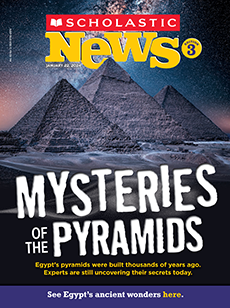1. Why do you think the author calls the fossils that Ruby and her dad found “an amazing discovery”?
Sample response: The author calls the fossils “an amazing discovery” because they belonged to the largest ocean reptile ever found. The creature was an ichthyosaur no one knew of before.
(RI.3.1 Text evidence)
2. What does the article tell you about the job of a paleontologist?
The article gives several clues about the job of a paleontologist. It says that paleontologists study creatures that lived long ago, like ichthyosaurs. It also explains that these scientists use shovels to dig for fossils, then work to identify the living thing those fossils came from.
(RI.3.2 Key Details)
3. What is the purpose of the sidebar, “Measuring Up”?
The purpose of the sidebar, “Measuring Up,” is to show how the size of Ichthyotitan severnensis compares with the size of sea creatures that are alive today.
(RI.3.5 Text Features)
